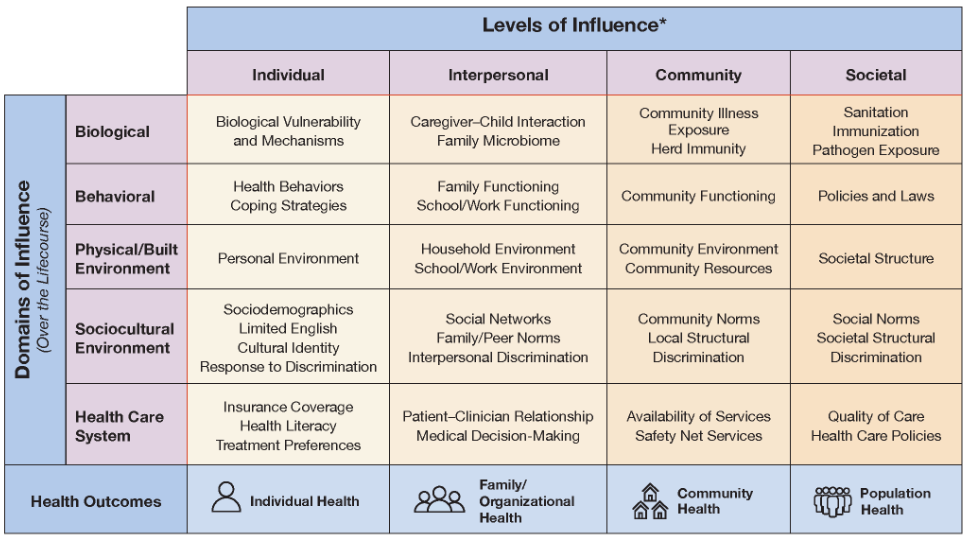What is Health Disparities Research?
, by DCEG Cancer Health Disparities Interest Group & Working Group
Health equity1 is achieved when everyone can attain their full potential for health and well-being. Health disparities2,3 are health differences due to sociocultural, behavioral, environmental, and/or health care/system factors. Biological factors are health determinants that influence health disparities; however, biological differences between population groups are closely related to social determinants and are not necessarily due to inherent biology or genetics. Cancer health disparities4 are adverse differences between certain groups of people that include: a disproportionate number of new cases or deaths; access to screening; access to quality cancer care; stage at diagnosis; cancer risk factors; cancer-related health complications; survivorship; and quality of life.
Populations That Experience Health Disparities in the U.S.5
- Racial and ethnic minoritized6 populations (self-identified American Indian or Alaska Native, Asian American, Black or African American, Hispanic or Latina/o, Native Hawaiian or other Pacific Islander, and mixed race or ethnicity)
- Populations from socioeconomically disadvantaged backgrounds (e.g., income, education)
- Underserved rural populations
- Sexual and gender minority populations
- People with disabilities (cognitive, sensory, or physical disability)*
- Immigrant populations*
- Populations that have historically experienced discrimination or exclusion (e.g., religion)*
Recommendations for Health Disparity Researchers
- Understand definitions of health disparities and populations that experience health disparities.
- Recognize the limitations of basic science approaches when studying the health of racial and ethnic minoritized6 populations. Race is a sociocultural construct. Racism, not race, is largely responsible for racial disparities in health.
- Consider designing health disparity studies that investigate other influences beyond biological and individual levels (e.g., behavioral, sociocultural environment; community). See the National Institute on Minority Health and Health Disparities Research Framework
- Move beyond documenting disparities and towards approaches that identify structural drivers to inform interventions and public health policies aimed at increasing health equity.
- Actively engage with stakeholders, community leaders, and established health disparity experts, especially those from systematically excluded communities.
- Ensure equity in the opportunity for participation in research studies for both scientists and study participants.
Contributing Authors
DCEG Fellows’ Cancer Health Disparities Interest Group (Drs. Jongeun Rhee, Brittany Lord, Wayne Lawrence, Jacqueline B. Vo, Sarah Jackson, Cody Ramin, Jennifer McGee-Avila, and Alexandra Harris) and DCEG Cancer Health Disparities Working Group (Drs. Jiyeon Choi and Constanza Camargo). We appreciate valuable feedback from Drs. Jackie Lavigne, Anil Chaturvedi, Jessica Madrigal, and Ms. Jennifer Loukissas (DCEG), and Drs. Anna María Nápoles and Monica Webb Hooper (National Institute on Minority Health and Health Disparities).
*These population groups are not included in the NIH designated populations that experience health disparities5, but were added additionally through reference [2], [3].
References
- Health Equity. World Health Organization.
- U.S. Department of Health and Human Services. The Secretary’s Advisory Committee on National Health Promotion and Disease Prevention Objectives for 2020. Phase I report: Recommendations for the framework and format of Healthy People 2020. Section IV: Advisory Committee findings and recommendations (pdf, 1681 KB).
- Duran DG, Pérez-Stable EJ. Novel Approaches to Advance Minority Health and Health Disparities Research. Am J Public Health 2019 Jan;109(S1):S8-S10. doi: 10.2105/AJPH.2018.304931. PMCID: PMC6356124.
- Cancer Disparities. National Cancer Institute.
- Minority Health and Health Disparities: Definitions and Parameters. National Institute on Minority Health and Health Disparities.
- Advancing Health Equity: A Guide to Language, Narrative and Concepts (pdf, 516 KB). American Medical Association and Association of American Medical Colleges.
Browse the archive of monthly messages and learn more about the Inclusivity Minute project.
